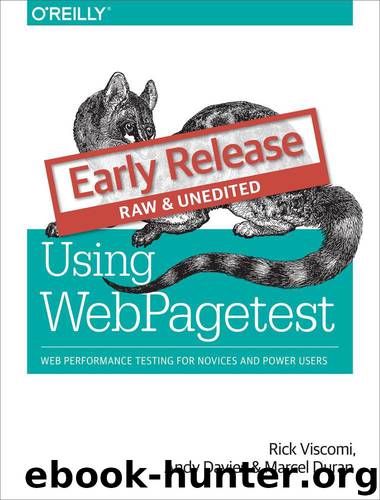Using WebPagetest by Rick Viscomi Andy Davies and Marcel Duran

Author:Rick Viscomi, Andy Davies, and Marcel Duran
Language: eng
Format: mobi, epub
Tags: COMPUTERS / Web / Web Programming
ISBN: 9781491902578
Publisher: O’Reilly Media
Published: 2014-06-24T16:00:00+00:00
Figure 7-3. Under the Advanced Settings section, the Auth tab can be used to input a username and password. This data will be sent to the test page in the form of an Authorization header.
This is the simplest way to configure WebPagetest to log you in as a particular user. Keep in mind, though, that the account credentials are sent in plain text in the HTTP headers. For example, here would be the request header generated by entering a username of “username” and a password of “password” into the Auth tab:
Authorization: Basic dXNlcm5hbWU6cGFzc3dvcmQ=
The name of the header is Authorization, whose value contains text that should be interpreted as account credentials. The keyword Basic is a hint to the server how to interpret the encoded value. In this case, the value is a base64-encoded string of a username and password delimited by a colon. In other words, "dXNlcm5hbWU6cGFzc3dvcmQ=" is "username:password" in base64 encoding. With this data, the server can decode and parse the credentials and authenticate the user.
It’s up to the server to support HBA, so this is not always a reliable way to authenticate a test. Still, it is the most straightforward method offered by WebPagetest to log in to a test website.
Download
Using WebPagetest by Rick Viscomi Andy Davies and Marcel Duran.epub
This site does not store any files on its server. We only index and link to content provided by other sites. Please contact the content providers to delete copyright contents if any and email us, we'll remove relevant links or contents immediately.
The Mikado Method by Ola Ellnestam Daniel Brolund(20293)
Hello! Python by Anthony Briggs(19619)
Secrets of the JavaScript Ninja by John Resig Bear Bibeault(17890)
Dependency Injection in .NET by Mark Seemann(17855)
The Well-Grounded Java Developer by Benjamin J. Evans Martijn Verburg(17296)
Kotlin in Action by Dmitry Jemerov(16849)
Sass and Compass in Action by Wynn Netherland Nathan Weizenbaum Chris Eppstein Brandon Mathis(13111)
Secrets of the JavaScript Ninja by John Resig & Bear Bibeault(11266)
Jquery UI in Action : Master the concepts Of Jquery UI: A Step By Step Approach by ANMOL GOYAL(9279)
Svelte with Test-Driven Development by Daniel Irvine(8138)
Test-Driven Development with PHP 8 by Rainier Sarabia(7887)
Layered Design for Ruby on Rails Applications by Dementyev Vladimir;(7707)
Web Development with Django by Ben Shaw Saurabh Badhwar(7216)
React Application Architecture for Production by Alan Alickovic(6896)
Software Architecture for Web Developers by Mihaela Roxana Ghidersa(4980)
Audition by Ryu Murakami(4878)
Accelerating Server-Side Development with Fastify by Manuel Spigolon Maksim Sinik & Matteo Collina(4835)
Solidity Programming Essentials by Ritesh Modi(4558)
Build Your Own Web Framework in Elixir by Aditya Iyengar(4434)
